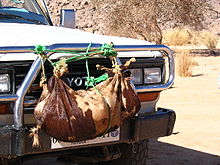Wineskin

A wineskin is an elastic container in which wine is traded and tapped from the wine. In ancient times and in the Middle Ages, wineskins were a common means of transport alongside amphorae and barrels .
Today, wine tubes are mostly made of plastic or plastic wrapped in aluminum foil . Usually they are wrapped in a decorative cardboard box and have a tap. Common sizes are 3 and 5 liters and are also called Cubitainers in French . International / technological usage is bag-in-box .
The tapping device is designed in such a way that the wine leaves the hose, but no air gets in. Similar to a tube of toothpaste that you squeeze out, the tube becomes emptier and empty without the remaining wine being able to oxidize. It is therefore possible to drink the opened tube gradually empty for up to two months without the wine losing any of its quality.
In the meantime, not only the simplest, but also medium qualities are increasingly being sold in wineskin in Germany. There are also some AOC wines from Bordeaux from independent winemakers on the German market. As a rule, however, lower quality levels such as table and country wines are usually offered.
Trivia
The biblical phrase about the new wine in old bottles refers to the leather containers of this type.
